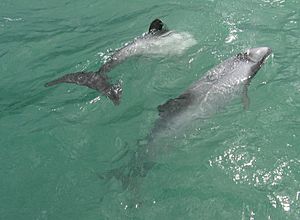Mammals of New Zealand facts for kids
New Zealand is a special country known for its unique wildlife. Before people arrived, the only mammals living on land were a few types of bats. All other mammals were marine mammals, meaning they lived in the ocean, like whales, dolphins, and seals. Long, long ago, during a time called the Miocene, there was also an ancient land mammal called the Saint Bathans mammal.
When the Māori came to New Zealand around 1250 CE, they brought two new mammals: the kurī (a type of dog) and the kiore (a Polynesian rat). Later, starting in 1769, European settlers brought many more animals. These included pigs, mice, different kinds of rats, weasels, stoats, ferrets, and possums. Some of these introduced animals have caused problems for New Zealand's native wildlife.
Contents
Native Mammals of New Zealand
New Zealand's native mammals are quite unique because most of them live in the sea. The only land mammals that were here naturally were bats.
Types of Native Mammals
- Bats: There were three main types of bats. These were the long-tailed bat, the greater short-tailed bat, and the lesser short-tailed bat. Fossils show that these bats lived all over New Zealand. Even older fossils from the Miocene period show that there were many more kinds of bats long ago.
- Whales and Dolphins: Many different kinds of whales and dolphins live in the waters around New Zealand. One special dolphin, the Hector's dolphin, is found only in New Zealand.
- Seals and Sea Lions: Seven different species of seals and sea lions call New Zealand home. These include fur seals and sea lions.
- Ancient Mammal: The Saint Bathans mammal is an ancient land mammal. Scientists found its fossils from the Miocene period. This shows that New Zealand once had more land mammals.
Conservation Status of Native Mammals
Many of New Zealand's native mammals are in danger. This means their populations are very small.
- Bats:
- The New Zealand lesser short-tailed bat is considered endangered. This means it is at high risk of becoming extinct.
- The New Zealand greater short-tailed bat is thought to be extinct. The last time anyone saw one was in 1967.
- The New Zealand long-tailed bat is critically endangered. This is the highest risk level before extinction.
- Whales and Dolphins:
- Large whales like the sei, fin, and blue whale are all endangered.
- The Hector's dolphin, which only lives in New Zealand, is also endangered.
The Department of Conservation works hard to protect these animals. They use a system called the New Zealand Threat Classification System. This system helps them decide which animals need the most help.
Introduced Mammals in New Zealand
Many mammals were brought to New Zealand by people. These are called introduced species.
Mammals Introduced by Māori
The Māori were the first to introduce mammals to New Zealand. They brought two species:
Mammals Introduced by Europeans
European settlers brought many more mammal species. They started arriving in the late 1700s. Some of these animals were brought for farming or hunting. Others arrived by accident.
Here are some of the mammals introduced by Europeans:
- Cats: Introduced as early as 1820.
- Cattle: Brought in 1814 for farming.
- Common brushtail possum: Introduced in 1837. They are now a big problem for native plants and birds.
- Deer: Several types of deer were introduced for hunting. These include European fallow deer (1864), Red deer (from 1851), and Sambar deer (1875-76).
- European hedgehog: Introduced around 1870.
- European hare: Introduced in 1851.
- Ferrets, Stoats, and Weasels: These small predators were brought to control rabbits. However, they also hunt native birds. Ferrets arrived in 1879.
- Goats: Introduced in the late 1700s.
- House mouse: These small rodents arrived with settlers.
- Rabbits: The European rabbit was introduced in 1838. They caused huge problems for farms.
- Rats: Besides the kiore, the Black rat and Brown rat were also introduced.
- Sheep: Brought in 1773 for wool and meat.
- Wild boar: Introduced in 1773.
Many of these introduced mammals have had a big impact on New Zealand's environment. Some compete with native animals for food. Others hunt native birds and insects. This is why conservation efforts are so important in New Zealand.


